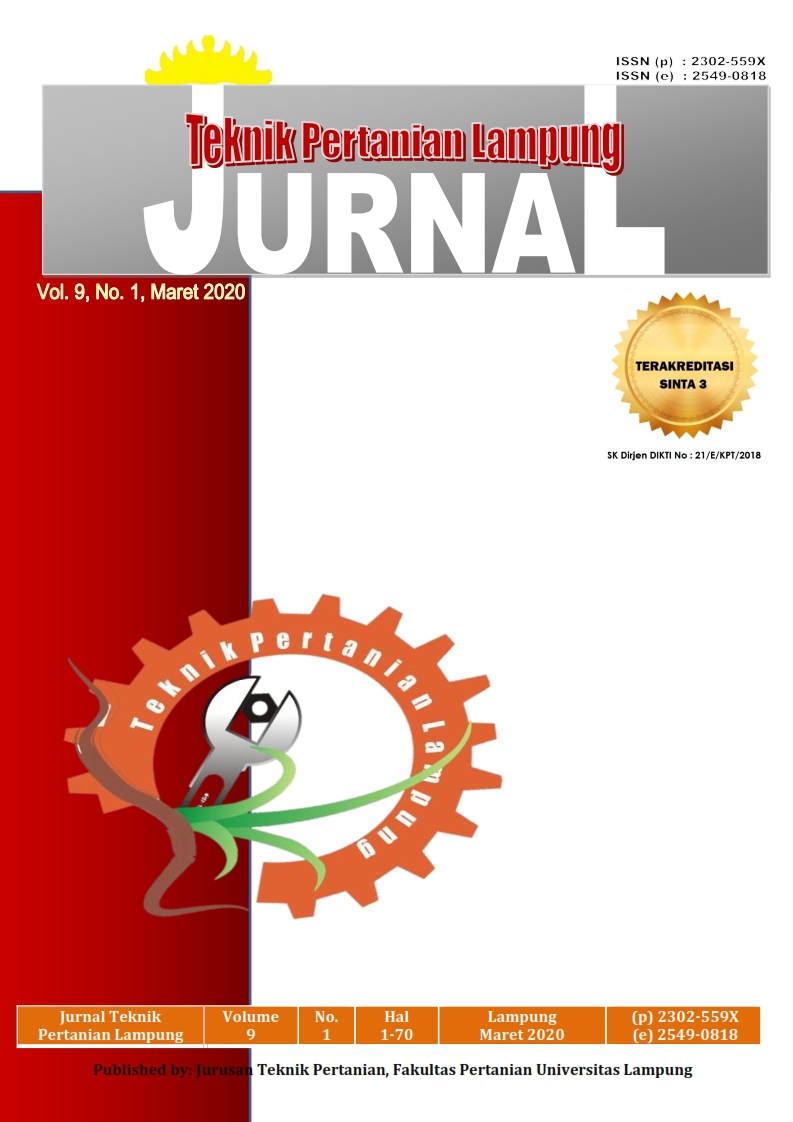NONTHERMAL PLASMA: A REVIEW ON ITS PROSPECTS ON FOOD PROCESSING
DOI:
https://doi.org/10.23960/jtep-l.v9i1.48-54Abstract
Bringing plasma into food processing is a relatively new measure for food engineer and scientist. It is simple in generation, low energy requirement, high efficacy, and easy to apply, pave its way to be a new prospective scenario in processing more safety food recently. Plasma is the fourth matter after solid, liquid and gas contain various reactive species generated by electrical discharge from 10-120kV. Those are Reactive Oxygen and Nitrogen (RONS) comprising various reactive species including nitric oxide (NO), superoxide (O2-), hydrogen peroxide (H2O2); singlet oxygen (1O2); ozone (O3) and even hydroxyl radical (-OH) which can and do play important roles in biological systems. This brief review describes plasma interaction with the biological system and pesticides compound and sums up some finding on the nonthermal application on two main consideration of food safety namely microorganisms decontamination and pesticides residue degradation.References
Dobrynin, D., Fridman, G., Friedman, G., & Fridman, A. (2009). Physical and biological mechanisms of direct plasma interaction with living tissue. New Journal of Physics, 11(11), 115020. https://doi.org/10.1088/1367-2630/11/11/115020
Dröge, W. (2002). Free Radicals in the Physiological Control of Cell Function. Physiological Reviews, 82(1), 47–95. https://doi.org/10.1152/physrev.00018.2001
Food, & Organization, A. (1986). International code of conduct on the distribution and use of pesticides. na.
Frederickson Matika, D. E., & Loake, G. J. (2014). Redox Regulation in Plant Immune Function. Antioxidants & Redox Signaling, 21(9), 1373–1388. https://doi.org/10.1089/ars.2013.5679
Jeyaratnam, J. (1990). Acute pesticide poisoning: A major global health problem.
Kaushik, G., Satya, S., & Naik, S. N. (2009). Food processing a tool to pesticide residue dissipation – A review. Food Research International, 42(1), 26–40. https://doi.org/10.1016/j.foodres.2008.09.009
Kjellander, J., & Nygren, B. (1957). B. cereus och fodoamnen. Nord Hyg, 38, 36–45.
Liao, X., Liu, D., Xiang, Q., Ahn, J., Chen, S., Ye, X., & Ding, T. (2017). Inactivation mechanisms of non-thermal plasma on microbes: A review. Food Control, 75, 83–91. https://doi.org/10.1016/j.foodcont.2016.12.021
Ling, Y., Wang, H., Yong, W., Zhang, F., Sun, L., Yang, M.-L., … Chu, X.-G. (2011). The effects of washing and cooking on chlorpyrifos and its toxic metabolites in vegetables. Food Control, 22(1), 54–58. https://doi.org/10.1016/j.foodcont.2010.06.009
Lu, X., Naidis, G. V., Laroussi, M., Reuter, S., Graves, D. B., & Ostrikov, K. (2016). Reactive species in non-equilibrium atmospheric-pressure plasmas: Generation, transport, and biological effects. Physics Reports, 630, 1–84. https://doi.org/10.1016/j.physrep.2016.03.003
Lu, XinPei, Ye, T., Cao, Y., Sun, Z., Xiong, Q., Tang, Z., … Pan, Y. (2008). The roles of the various plasma agents in the inactivation of bacteria. Journal of Applied Physics, 104(5), 053309. https://doi.org/10.1063/1.2977674
Magee, R. J. (1964). Pesticide Literature and Pesticide Research. Journal of Chemical Documentation, 4(4), 195–196. https://doi.org/10.1021/c160015a001
Misra, N.N., Pankaj, S. K., Walsh, T., O’Regan, F., Bourke, P., & Cullen, P. J. (2014). In-package nonthermal plasma degradation of pesticides on fresh produce. Journal of Hazardous Materials, 271, 33–40. https://doi.org/10.1016/j.jhazmat.2014.02.005
Misra, N.N., Patil, S., Moiseev, T., Bourke, P., Mosnier, J. P., Keener, K. M., & Cullen, P. J. (2014). In-package atmospheric pressure cold plasma treatment of strawberries. Journal of Food Engineering, 125, 131–138. https://doi.org/10.1016/j.jfoodeng.2013.10.023
Misra, Nrusimha Nath, Keener, K. M., Bourke, P., Mosnier, J.-P., & Cullen, P. J. (2014). In-package atmospheric pressure cold plasma treatment of cherry tomatoes. Journal of Bioscience and Bioengineering, 118(2), 177–182. https://doi.org/10.1016/j.jbiosc.2014.02.005
Moisan, M., Barbeau, J., Crevier, M.-C., Pelletier, J., Philip, N., & Saoudi, B. (2002). Plasma sterilization. Methods and mechanisms. Pure and Applied Chemistry, 74(3), 349–358. https://doi.org/10.1351/pac200274030349
Sarangapani, C., O’Toole, G., Cullen, P. J., & Bourke, P. (2017). Atmospheric cold plasma dissipation efficiency of agrochemicals on blueberries. Innovative Food Science & Emerging Technologies, 44, 235–241. https://doi.org/10.1016/j.ifset.2017.02.012
Schnabel, U., Niquet, R., Schlüter, O., Gniffke, H., & Ehlbeck, J. (2015). Decontamination and Sensory Properties of Microbiologically Contaminated Fresh Fruits and Vegetables by Microwave Plasma Processed Air (PPA): Decontamination and Sensory of Food By Plasma. Journal of Food Processing and Preservation, 39(6), 653–662. https://doi.org/10.1111/jfpp.12273
Zhou, R., Zhou, R., Yu, F., Xi, D., Wang, P., Li, J., … Ostrikov, K. (Ken). (2018). Removal of organophosphorus pesticide residues from Lycium barbarum by gas phase surface discharge plasma. Chemical Engineering Journal, 342, 401–409. https://doi.org/10.1016/j.cej.2018.02.107
Ziuzina, D., & Misra, N. N. (2016). Cold Plasma for Food Safety. In Cold Plasma in Food and Agriculture (pp. 223–252). https://doi.org/10.1016/B978-0-12-801365-6.00009-3
Downloads
Published
Issue
Section
License
- Authors who publish with this journal agree to the following terms:
- Authors retain copyright and grant the journal right of first publication with the work simultaneously licensed under a Creative Commons Attribution-ShareAlike 4.0 International Lice that allows others to share the work with an acknowledgement of the work's authorship and initial publication in this journal.
- Authors are able to enter into separate, additional contractual arrangements for the non-exclusive distribution of the journal's published version of the work (e.g., post it to an institutional repository or publish it in a book), with an acknowledgement of its initial publication in this journal.
- Authors are permitted and encouraged to post their work online (e.g., in institutional repositories or on their website) prior to and during the submission process, as it can lead to productive exchanges, as well as earlier and greater citation of published work (See The Effect of Open Access).
Jurnal Teknik Pertanian Lampung

JTEPL is licensed under a Creative Commons Attribution-ShareAlike 4.0 International License.

